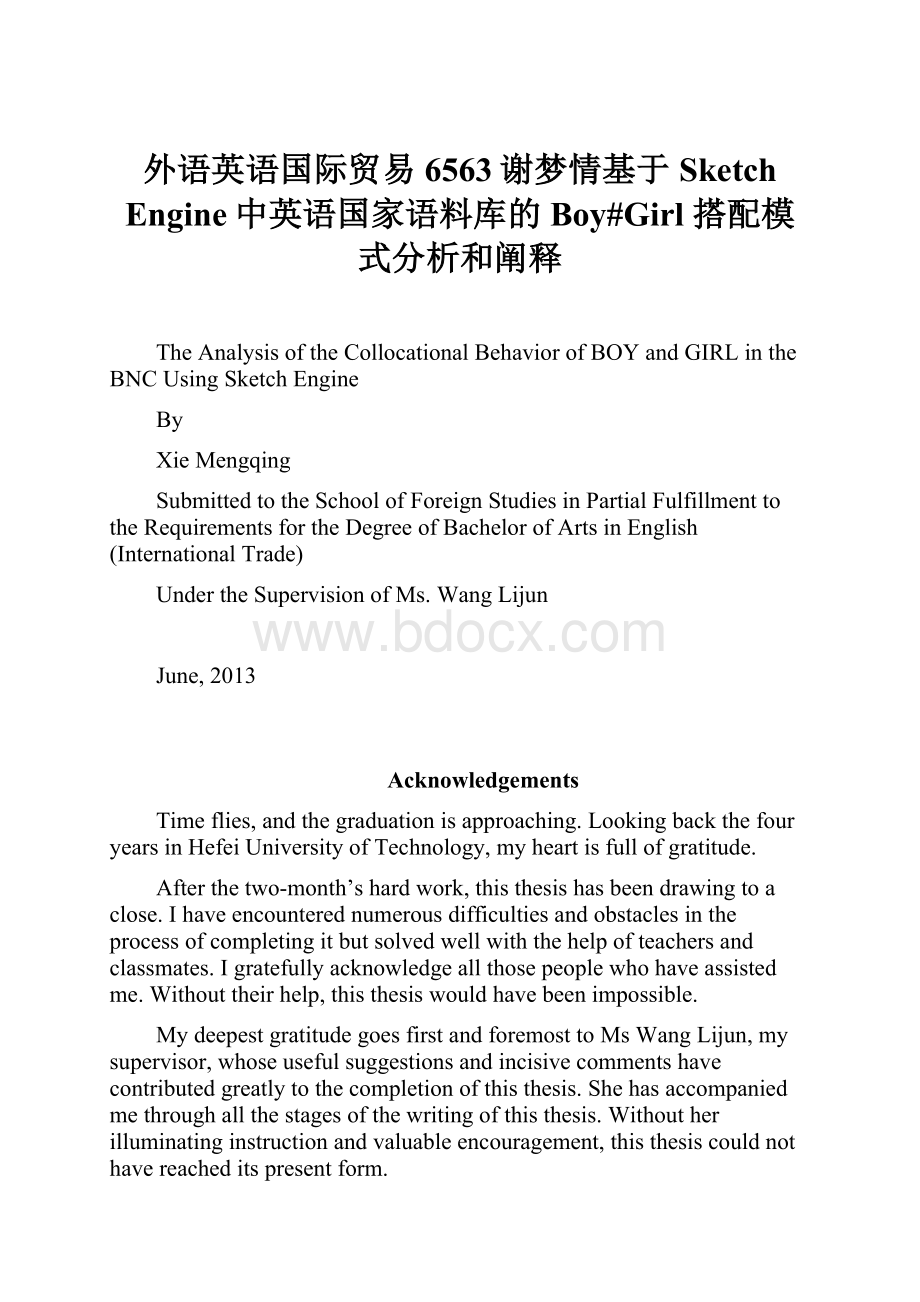外语英语国际贸易6563谢梦情基于Sketch Engine中英语国家语料库的Boy#Girl 搭配模式分析和阐释.docx
《外语英语国际贸易6563谢梦情基于Sketch Engine中英语国家语料库的Boy#Girl 搭配模式分析和阐释.docx》由会员分享,可在线阅读,更多相关《外语英语国际贸易6563谢梦情基于Sketch Engine中英语国家语料库的Boy#Girl 搭配模式分析和阐释.docx(26页珍藏版)》请在冰豆网上搜索。

外语英语国际贸易6563谢梦情基于SketchEngine中英语国家语料库的Boy#Girl搭配模式分析和阐释
TheAnalysisoftheCollocationalBehaviorofBOYandGIRLintheBNCUsingSketchEngine
By
XieMengqing
SubmittedtotheSchoolofForeignStudiesinPartialFulfillmenttotheRequirementsfortheDegreeofBachelorofArtsinEnglish(InternationalTrade)
UndertheSupervisionofMs.WangLijun
June,2013
Acknowledgements
Timeflies,andthegraduationisapproaching.LookingbackthefouryearsinHefeiUniversityofTechnology,myheartisfullofgratitude.
Afterthetwo-month’shardwork,thisthesishasbeendrawingtoaclose.Ihaveencounterednumerousdifficultiesandobstaclesintheprocessofcompletingitbutsolvedwellwiththehelpofteachersandclassmates.Igratefullyacknowledgeallthosepeoplewhohaveassistedme.Withouttheirhelp,thisthesiswouldhavebeenimpossible.
MydeepestgratitudegoesfirstandforemosttoMsWangLijun,mysupervisor,whoseusefulsuggestionsandincisivecommentshavecontributedgreatlytothecompletionofthisthesis.Shehasaccompaniedmethroughallthestagesofthewritingofthisthesis.Withoutherilluminatinginstructionandvaluableencouragement,thisthesiscouldnothavereacheditspresentform.
Second,IwouldliketoexpressmyappreciationtoMsHuangJuan,wholedmeintotheworldofAdvancedEnglish.IamalsogreatlyindebtedtotheprofessorsandteachersattheDepartmentofEnglish:
ProfessorHanandMs.JangMin,whohaveinstructedandhelpedmealotinthepasttwoyears.
Lastmythankswouldgotomybelovedfamilyandroommatesfortheirlovingconsiderationsandgreatconfidenceinmethroughalltheseyears.Iexpresstoyourmymostsincerethanks.
TheAnalysisoftheCollocationalBehaviorofBOYandGIRLintheBNCUsingSketchEngine
Abstract:
Genderdifferenceinlanguageexistingindifferentcultures,isacommonphenomenon.SketchEngine-astrongcorpusquerysystem-isbeingusedasatooltostudythecollocationalbehaviorofBOYandGIRLintheBritishNationalCorpus(BNC).Inthisthesis,howtouseSketchEnginewillbedetailed.ThroughanalysisofthecollocatesofBOYandGIRL,itstimesandfrequency,thethesisaimstorevealthecollocationalwordsandpatternsofnounBOYandGIRLunderdifferentgrammaticalrelations,inordertoprovideconvincingdata,getridofnon-dataresearchingstage,andmakeresearchingresultsmorecredibleandpersuasive.
First,thisthesisstudiesthecollocationalbehaviorofBOYandGIRLfromthepointofpoweranddeviance.AnumberofadjectivesandverbsaspredicativereferringtoactionsrequiringphysicalstrengtharemorestronglyassociatedwithBOYthanwithGIRL.Andboysoftenexertpoweroverothersthroughtakingpartinviolentanddeviantactivities.Therefore,girlsaremoreeasilytobevictimsoftheviolentanddeviantactions,especiallythesexualactivities.Besides,girlsaremorelikelythanboystobevulnerableanddisadvantaged.Second,fromtheperspectiveofextraversionandagreeableness,conclusionsarethatBOYpatternsmorestronglywithextraversionwhileGIRLismuchmoreassociatedwithagreeableness.GIRLpatternsmorestronglywithgood-naturednessandkindnessthataretherepresentativesofagreeableness,whileBOYismorestronglyassociatedwithsuspicionanduncooperativenessthatarethemarkersofdisagreeableness.Third,fromtheviewofappearanceandsexuality,GIRLpatternsmorestronglywithbodilyshapes,weightandhaircolor,whileBOYpatternsmorestronglywithphysicalstrengthandprowess.BOYismoreeasilytobetheactorofsexualactivityandGIRListheobjectofsexualactivity.
TherearealsotwosimilaritiesexistingintheanalysisofthecollocationalbehaviorofBOY/GIRLintheBNC.Oneisthattheyarestronglyassociatedwithageandjuvenility.Theotheristhattheypatternsstronglywithwordsreferringtonationality,regionandethnicity.
KeyWord:
SketchEngine;CollocationalBehavior;BOYandGIRL;BNC
基于SketchEngine中英语国家语料库Boy/Girl搭模式分析和阐释
摘要:
男女性别语言的差异存在于不同文化之中,是一种普遍现象。
本文运用一个强大的语料库检索工具SketchEngine,根据BritishNationalCorpus语料库中的事实语料,研究boy/girl在英语国家语料库(BNC)中的词汇语法搭配模式。
本文将详细介绍SketchEngine以及BritishNationalCorpus的用法,并通过分析名词boy和girl作为主语、宾语和形容词中心语的有语法关联的搭配词以及搭配词出现的次数和频率,从而揭示在不同的语法关系下boy和girl倾向于搭配的词汇及不同的搭配模式,为性别语言差异的研究提供有力的数据支持,摆脱非数据研究阶段,使研究结果更具可信度和说服力。
首先,从权力与异常行为角度解读boy/girl的搭配模式。
通过研究BOY/GIRL搭配的形容词和作主语所搭配的动词发现BOY比GIRL更倾向于与代表体力动作的词相联系,且BOY常通过暴力和异常行为来展现自己的权力和力量。
GIRL则更倾向于成为BOY展示权力的对象,即暴力和异常行为的受害者,尤其是性行为。
而且GIRL更容易和代表脆弱与弱势的词联系在一起。
再次,从外向性与亲和性角度解读BOY/GIRL的搭配模式。
研究表明BOY更具有外向性。
GIRL更富有亲和性。
它更倾向与性格温和、品格优良的词搭配,而BOY则倾向于不合作、怀疑等反亲和性的词搭配。
最后,从外表与性的角度可以发现GIRL更强烈的与身材、头发颜色等表现外貌的词相联系,BOY则更易与代表力量和勇猛的词相联系。
BOY更多的为性行为的施动者,GIRL为受动者。
通过对BNC中BOY/GIRL搭配词的研究,不仅发现了BOY/GIRL存在的性别差异,也体现出BOY/GIRL的两点相同点。
第一,都倾向与表现年龄及不成熟的词搭配;第二,都与表示民族、宗教信仰和种族等类的词有着强烈的联系。
关键字:
SketchEngine,搭配行为,男孩和女孩,英语国家语料库
Contents
Acknowledgementsi
Abstractii
KeyWordsii
摘要iii
关键词iii
Contentsiv
ChapterOneIntroduction1
1.1Genderdifference1
1.2Literaturereview1
1.3Significanceofthethesis3
ChapterTwoIntroductiontoSketchEngineandtheBritishNationalCorpus……….4
2.1ThedevelopinghistoryoftheBNCandSketchEngine4
2.2TheprocedureofSketchEngine4
2.2.1Wordsketch5
2.2.2Wordsketchdifference6
ChapterThreeTheCollocationalBehaviourofBOYandGIRL83.1ThedifferentcollocationalbehaviorofBOYandGIRL8
3.1.1Poweranddeviance8
3.1.2Extraversionandagreeableness11
3.1.3Appearanceandsexuality14
3.2TheSimilarCollocationalBehaviorofBOYandGIRL……………………..153.2.1Ageandjuvenility....163.2.2Nationalityandethnicity16
ChapterFourConclusion
18
4.1Conclusion……………………..………………………………………….....18
4.2Limitationofthestudyandsuggestionsforfutureresearch……….………...18
Bibliography21
TheAnalysisoftheCollocationalBehaviorofBOYandGIRLintheBNCUsingSketchEngine
ChapterOneIntroduction
1.1Genderdifference
Genderdifferenceinlanguagehasbeenacknowledgedformanyyears.However,thestudyofitstartedlate.Inthe20thcentury,theDanishlinguistJespersonfirststudiedthegenderdifferenceinlanguagefromtheperspectiveoflinguistics.Jesperson(1922)detailedthecharacteristicofwomenlanguageinLanguage:
ItsNature,DevelopmentandOrigin.Butintheperiodoftheearly20thcentury,itwasverylooseandunsystematic,aspersonalresearchandinformaldiscussion.Whenitcametothe1970s,somefamouslinguists,suchasLakeoff,Labov,Trudgil,Thorne,Zimmerman&West,Henleyandsoon,furtheredonthedevelopmentofgenderdifferenceinlanguage.Theynotonlyresearchedsexismandgenderdifferenceinlanguage,butalsoprobedintothesocialrootswhichledtogenderdifferenceinlanguagethroughsociolinguistics.Fromthenon,plentyofmonographsandessayscameout.Nowadays,corpus-analytictechnique,whichuseselectroniccorporatoderivesocialandculturalinformation,isreallypopularinthestudyofgenderdifferenceinlanguage.
1.2Literaturereview
Gendereditemsincorporahavebeenlookedatbylotsofstudiesinwesterncountries,especiallyreferringtoasymmetryandsexism.Kjellmer(1986)testedthemaleandfemalepronouns’frequencyanddistribution.Inthe1961,healsousedthewordsman/menandwoman/womenBrownandLondon-Oslo-Bergen(LOB)corpora.Hefoundthat,generallyspeaking,inthesetwocorpora,“male”itemsoccurredmorefrequentlythan“female”ones.ButwhencomparedtotheBritishLOBcorpus,henoticedamasculinediscriminationintheNorth-AmericanBrowncorpus.Laterasimilarbiastowardsthemasculinewasshowninmanyresearches.Caldas-CoulthardandMoon(1999)checkedtheadjectivesassociatedwiththenounsmanandwomaninacorpusofUKnewsthesisarticles,andnotedthatwomanismodifiedobviouslybyadjectivesrelatingtophysicalappearance(e.g.,fair,prettiestandlovely),andonlymanismodifiedobviouslybyadjectivessuggestingsignificance(e.g.,key,bigandmain).Thesecollocationalpatternscanuncovertheconnotationsandmeaningsofwordsandtheculturalmeaningstheyrepresent(Stubbs1996:
172).However,thestudyofgenderdifferenceinlanguagedidnotconfinetofiguringlexicalitems.Anumberofanalystsbegantostudythecertainwordswhichoftentakeplaceincloseproximity(Baker2006:
96).GenderdifferenceinlanguagedemonstratingwithcollocationalbehaviorwasshowedinRomaine(2000).WecanseemanypairsoffamousgendereditemsthatrepresentaseriesofunsystematicandsemanticdiscriminationinEnglish.Shestudiedatman/womanandboy/girlandnoticedthatwoman/girlweremoreeasilyassociatedwithwordsthathadnegativemeaningsthanman/boy(Table1-1).
Table1-1:
Collocateswithman/womanandboy/girlinathreemillionwordsub-corpusoftheBNC(Romaine2000:
110)
woman
girl
man
boy
blonde
25
28
1
1
frigid
2
0
0
0
honest
11
2
68
1
hysterical
14
1
0
0
intelligent
17
9
44
3
loose
3
2
1
1
neurotic
2
2
2
0
silly
16
35
0
10
ugly
6
4
0
0
StudiesofwesterncountrieshavegreatinfluenceonChineselinguists.Theystartedtodiveintogenderdifferenceinlanguagefromthe1980s.Plentyofrelevantresearchtopicsinthisrealmwereproposedbylinguists.Forexample,ChenYuan(1983)inSociolinguisticsandChenSongceng(1985)inAnIntroductiontoSociolinguisticsreferredtotheideaof“gender-language”.ShenXiaolong(1996)elaboratelyintroducedthehypothesiswhichputforwardbywesternlinguists.Meanwhile,Chineselinguistsalsobegantowritesomeoverviewarticlespublishedontheacademicperiodicals.“Areviewofresearchonlanguageandgender”byDaiWeidong(1983),AreviewofresearchongenderdifferenceinEnglishbyWangZhenjing(2002)werethesignifican